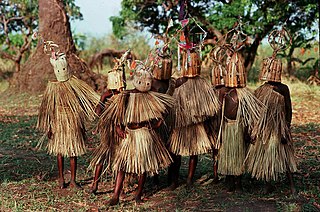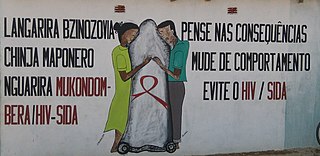
Mozambique, officially the Republic of Mozambique, is a country located in southeastern Africa bordered by the Indian Ocean to the east, Tanzania to the north, Malawi and Zambia to the northwest, Zimbabwe to the west, and Eswatini and South Africa to the southwest. The sovereign state is separated from the Comoros, Mayotte and Madagascar by the Mozambique Channel to the east. The capital and largest city is Maputo.

Swahili, also known by its local name Kiswahili, is the native language of the Swahili people, who are found primarily in Kenya, Tanzania and Mozambique. It is a Bantu language, though Swahili has borrowed a number of words from foreign languages, particularly Arabic and Persian, but also words from Portuguese, English and German. Around forty percent of Swahili vocabulary consists of Arabic loanwords, including the name of the language. The loanwords date from the era of contact between Arab traders and the Bantu inhabitants of the east coast of Africa, which was also the time period when Swahili emerged as a lingua franca in the region. The number of Swahili speakers, be they native or second-language speakers, is estimated to be around 80 million.

The Makua people, also known as Makhuwa, are a Bantu ethnic group found in northern Mozambique and the southern border provinces of Tanzania such as the Mtwara Region. They are the largest ethnic group in Mozambique, and primarily concentrated in a large region to the north of the Zambezi River.
The Swahili people comprise mainly Bantu, Afro-Arab and Comorian ethnic groups inhabiting the Swahili coast, an area encompassing the Zanzibar archipelago and mainland Tanzania's seaboard, littoral Kenya, northern Mozambique, the Comoros Islands, southwestern Somalia and Northwest Madagascar. The original Swahili distinguished themselves from other Bantu peoples by self-identifying as Waungwana. In certain regions, this differentiation is even more stratified in terms of societal grouping and dialect, hinting to the historical processes by which the Swahili have coalesced over time. More recently, however, Swahili identity extends to any person of African descent who speaks Swahili as their first language, is Muslim and lives in a town on the main urban centres of most of modern-day Tanzania and coastal Kenya, northern Mozambique and the Comoros, through a process of swahilization.
The Makonde are an ethnic group in southeast Tanzania, northern Mozambique, and Kenya. The Makonde developed their culture on the Mueda Plateau in Mozambique. At present they live throughout Tanzania and Mozambique, and have a small presence in Kenya. The Makonde population in Tanzania was estimated in 2001 to be 1,140,000, and the 1997 census in Mozambique put the Makonde population in that country at 233,358, for an estimated total of 1,373,358. The ethnic group is roughly divided by the Ruvuma River; members of the group in Tanzania are referred to as the Makonde, and those in Mozambique as the Maconde. The two groups have developed separate languages over time but share a common origin and culture.

Makhuwa is the primary Bantu language of northern Mozambique. It is spoken by 4 million Makua people, who live north of the Zambezi River, particularly in Nampula Province, which is virtually entirely ethnically Makua. It is the most widely spoken indigenous language of Mozambique.

The Yao people are a major Bantu ethnic and linguistic group based at the southern end of Lake Malawi. They played an important role in the history of Southeast Africa, notably in the 19th century. The Yao are a predominantly Muslim-faith group of about two million, whose homelands encompass the countries of Malawi, the north of Mozambique, and the Ruvuma and Mtwara Regions of Tanzania. The Yao have a strong cultural identity, transcending national borders.
The Suba of Tanzania are a community of people in Rorya District, Mara Region, Tanzania speaking mutually intelligible varieties of the Suba language. They are mainly located in Nyancha, Luo-Imbo and Suba Divisions of Rorya District. The groups commonly listed as being part of the Suba community are the Hacha, Kine, Rieri, Simbiti, Surwa and Sweta. There are a total of around 80,000 ethnic Suba living in Tanzania, most of whom are still speaking the Suba language although some, particularly the Rieri, have started to speak Luo.

Mozambique is a multilingual country. A number of Bantu languages are indigenous to Mozambique. Portuguese, inherited from the colonial period, is the official language, and Mozambique is a full member of the Community of Portuguese Language Countries. Ethnologue lists 43 languages spoken in the country.
The Zyoba are an ethnic and linguistic group based near Lake Tanganyika in Tanzania and the Democratic Republic of the Congo who speak the Joba language.
The Akiek are an ethnic and linguistic group in Kenya, living in southern Kenya, with an estimated population of 3,700 people. The Akiek language is said to be a moribund language: only a few elderly speakers are left. The Akiek in Tanzania now speak Maasai, and those in Kenya speak kalenjin.
The Makwe are an ethnic and linguistic group based on the Indian Ocean coast in northern Mozambique and southern Tanzania. In 2003 the Makwe population was estimated to number 32,000, of which 22,000 live in Mozambique and 10,000 live in Tanzania. In Tanzania the Makwe language is also known as Maraba.
Gokomere is a place in Zimbabwe, 16 kilometres (9.9 mi) from Masvingo, known for its rock art and pottery traditions dating from 300 to 650 AD.
Articles related to Mozambique include:
The Chopi are an ethnic group of Mozambique. They have lived primarily in the Zavala region of southern Mozambique, in the Inhambane Province. They traditionally lived a life of subsistence agriculture, traditionally living a rural existence, although many were displaced or killed in the civil war that followed Mozambique's liberation from Portuguese colonial rule in 1975. In addition, drought forced many away from their homeland and into the nation's cities.
Portuguese Africans are Portuguese people born or permanently settled in Africa. The largest Portuguese African population lives in Portugal numbering over 1 million with large and important minorities living in South Africa, Namibia and the Portuguese-speaking African countries .The descendants of the Portuguese settlers who were born and "raised" locally since Portuguese colonial time were called crioulos. Much of the original population is unnumbered having been assimilated into Portugal, Brazil, and other countries.
Yao is a Bantu language in Africa with approximately two million speakers in Malawi, and half a million each in Tanzania and Mozambique. There are also some speakers in Zambia. In Malawi, the main dialect is Mangochi, mostly spoken around Lake Malawi. In Mozambique, the main dialects are Makale and Massaninga. The language has also gone by several other names in English, including chiYao or ciYao, Achawa, Adsawa, Adsoa, Ajawa, Ayawa, Ayo, Ayao, Djao, Haiao, Hiao, Hyao, Jao, Veiao, and waJao.
Makonde, or Kimakonde, is the language spoken by the Makonde, an ethnic group in southeast Tanzania and northern Mozambique. Makonde is a central Bantu language closely related to Yao. The Matambwe (Matembwe) and Mabiha (Maviha) dialects are divergent, and may not be Makonde.
Ngoni is a Bantu language of Zambia, Tanzania, and Mozambique. There is a 'hard break' across the Tanzanian–Mozambican border, with marginal mutual intelligibility. It is one of several languages of the Ngoni people, who descend from the Nguni people of southern Africa, and the language is a member of the Nguni subgroup, with the variety spoken in Malawi sometimes referred to as a dialect of Zulu. Other languages spoken by the Ngoni may also be referred to as "Chingoni"; many Ngoni in Malawi, for instance, speak Chewa, and other Ngoni speak Tumbuka or Nsenga.
The Makwe or Macue language, is a close relative of Swahili spoken on the coast of the Cabo Delgado Province of Mozambique, and across the border in Mtwara Region of Tanzania. Although it shares high lexical similarity (60%) with Swahili, it is not intelligible with it, nor with its cousin Mwani. Arends et al. suggest it might turn out to be a Makonde–Swahili mixed language.





